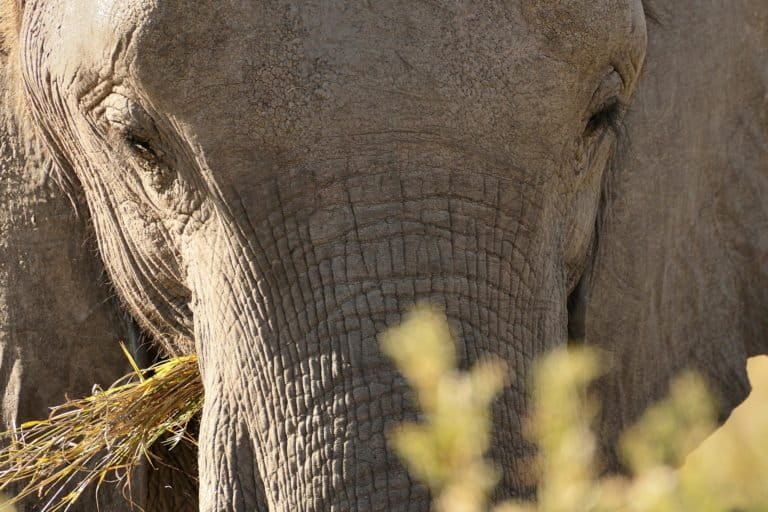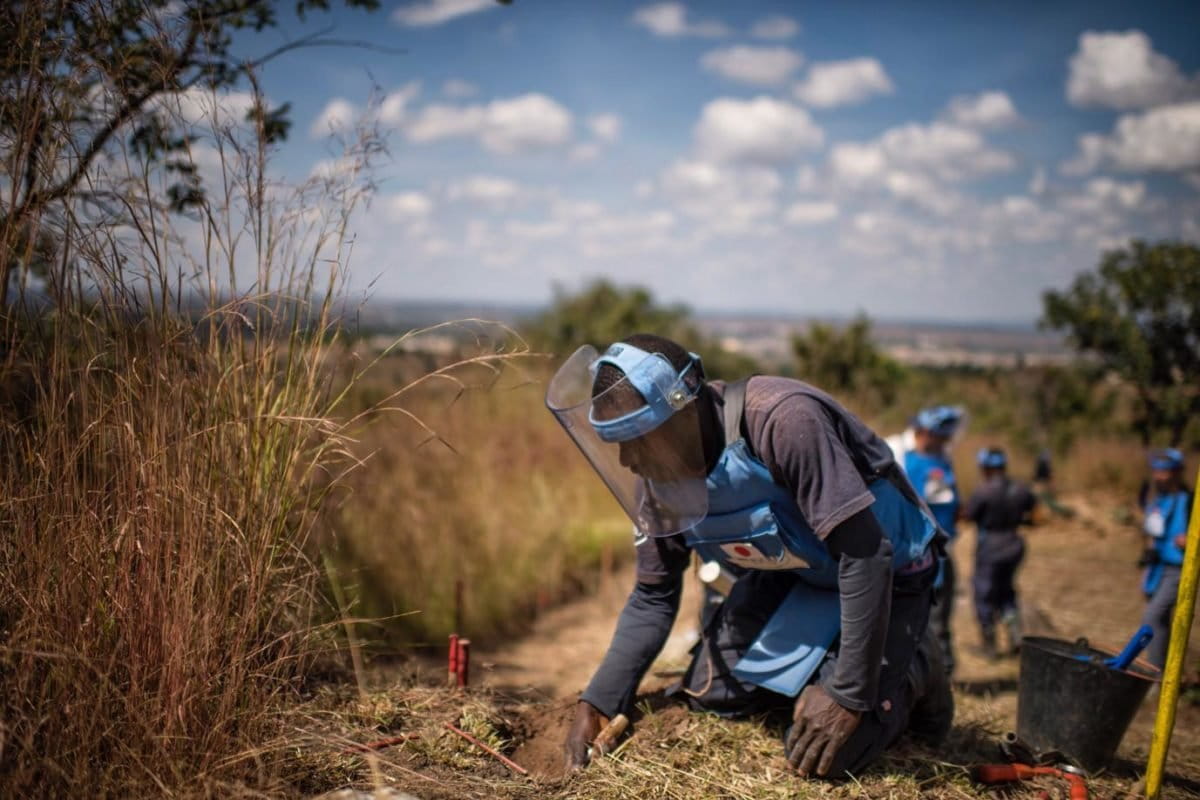- The Angolan government has announced a $60 million commitment to clear landmines in Luengue-Luiana and Mavinga national parks in the country’s southeast.
- The region is part of the Kavango-Zambezi Transfrontier Conservation Area — home to incredible natural biodiversity, but also one of the most heavily mined regions of Angola.
- International funding for landmine clearance has fallen by 80 percent over the last 10 years, and without new funding Angola will miss its target of clearing all landmines by 2025.
- The HALO Trust, a demining NGO, and the Angolan government hope that clearance of landmines will stimulate conservation in southeastern Angola and provide alternative livelihoods such as ecotourism to alleviate poverty and diversify the country’s economy away from oil.
The Angolan government has pledged $60 million to clear landmines in two national parks that form part of southern Africa’s highly biodiverse Kavango-Zambezi Transfrontier Conservation Area.
The country’s environment minister, Paula Coelho, made the announcement June 17 at a conference in London. The government has contracted the U.K.- and U.S.-based HALO Trust to clear 153 minefields in Luengue-Luiana and Mavinga national parks in the country’s southeastern province of Cuando Cubango.
“We are enthusiastic to be part of the initiative of the protection of the elephant and to develop long-term plans for protected areas,” Coelho told the conference.

Angola’s wildlife was decimated during 41 years of conflict — a 14-year struggle for independence followed by 27 years of civil war — that finally ended in 2002. In southeastern Angola, displaced civilians hunted wildlife to survive, while the UNITA faction, a belligerent in both conflicts, slaughtered elephants and sold the ivory, with the backing of the apartheid government in South Africa, to buy arms.
From 2004 to 2005, following the end of the civil war, aerial surveys by Michael Chase, a conservation researcher and founder of the South Africa-based group Elephants Without Borders, found signs that the elephant population in Luiana was increasing; at the same time, tracking of elephants tagged with collars in neighboring Botswana and Namibia showed they were returning to their former range in this part of Angola.
The Angolan government didn’t allow any further studies until 2015, when Chase returned as part of the Great Elephant Census. The Angolan portion of the census counted 3,400 elephants and an alarming carcass ratio of 30 percent, indicating threatening levels of poaching.
The civil war that followed Angolan independence was one of the many proxy battles of the Cold War, with UNITA backed by U.S. allies, and its main rival, the People’s Movement for the Liberation of Angola (MPLA), supported by the Soviets. As financial and military aid poured into the country, large amounts of ivory and rhinoceros horn were flowing out, according to a 1996 South African government inquiry. Vast numbers of landmines were laid: a 1997 report by Human Rights Watch found that 51 different types of mines, manufactured in 18 different countries, had been found in Angolan soil. Southeastern Angola saw the heaviest fighting during the civil war: in Cuando Cubango province alone there are 22 square kilometers (8.5 square miles) of confirmed minefields.
Seventeen years after the end of the war, landmines continue to restrict access to farmland across this part of the country, making it difficult for the government to extend development here, and deterring would-be ecotourists while at the same time creating ideal conditions for poachers, for whom the rewards offered by wildlife trafficking syndicates make the risk worthwhile.
“The land mine issue is something that is very important to remove because we [need] our economic development,” said Rui Mangueira, the Angolan ambassador to the U.K. “Angola could be one of the most beautiful destinations.”
Conservation, development and landmines: Interconnected issues
The southeastern corner of Angola is a vital piece of the 520,000-square-kilometer (201,000-square-mile) Kavango-Zambezi Transfrontier Conservation Area (KAZA), which includes both formal wildlife refuges and communally held land with rapidly growing populations. KAZA was set up in 2011 to manage this vast cross-border area with conservation as the primary form of land use, developing it as a sustainable tourism destination to benefit its resident communities while allowing wildlife, including megafauna such as the African elephant, to roam freely across historical ranges regardless of national borders.

In 2015, scientists returned to the region to explore the headwaters of the Okavango Delta, the largest freshwater wetland in southern Africa, as part of the National Geographic Society’s Okavango Wilderness Project. Navigating between the minefields with support from the HALO Trust, the team found a wealth of biodiversity, including more than 80 species new to science; to date, only 11 of them have been formally described.
Also speaking at the London conference, Kai Collins, director of the Okavango Wilderness Project, described the difficulty of operating in the region: “We couldn’t even get the teams in to start the expedition … without the assistance of HALO guiding us through the most heavily mined areas.”
“There is also a poverty that rises directly from the presence of these hundreds of minefields,” said James Cowan, CEO of the HALO Trust. “The communities that live in these areas cannot develop economically and become reliant on poaching and bush meat.”
Clearing landmines: A mammoth task
Angola has set a target of clearing all landmines from its territory by 2025. The national mine action agency, Comissão Nacional Intersectorial de Desminagem e Assistência Humanitária (CNIDAH), has cleared 56 percent of Angola’s known minefields to date. CNIDAH’s clearance work has been supported by international groups including the Mines Advisory Group, Norwegian People’s Aid and the HALO Trust, and has been heavily reliant on foreign donors.
But international funding for mine clearance in Angola has fallen drastically in recent years, from $48.1 million in 2005 to just $3.1 million in 2017. This fall was in part caused by a brief period when Angola reached middle-income status due to a rise in the price of oil, its main export. The loss of international funding has been compounded by a downturn in Angola’s economy; at current rates, Angola won’t achieve its mine-free vision until 2046.
The Angolan government hopes that ecotourism in areas like Cuando Cubango can help diversify its economy, as it has in neighbouring countries like Botswana. “The Angolan government knows it needs to diversify beyond oil,” Coelho said at the conference. “Angola knows it needs outside expertise and investment to help preserve its environment.”
Collins said he hopes the demining work can bring about change in southeastern Angola. “The opportunity is there of wildlife populations that just need to recover and be protected from poaching,” he said.
The Okavango Wilderness Project is looking at ways to create a “conservation economy” in the hope that as local people gain access to sustainable farming practices and alternative livelihoods through ecotourism, poaching and hunting for bushmeat will decrease.
The Angolan section of KAZA is also crucially important to the wider vision of an area where wildlife can roam freely across borders. In neighboring countries, instances of human-wildlife conflict are increasing as animal populations recover. KAZA’s supporters hope that a landmine-free Angola could offer important additional space for wildlife to disperse.
“Elephants, they do not recognize borders, they do not have passports but move freely,” Coelho said. “I would like to … open the corridors so that the pressure in the [southern African] region can be less and elephants can return home.”
Banner image: HALO Trust operatives clearing land mines in Angola. Image courtesy of the HALO Trust
FEEDBACK: Use this form to send a message to the author of this post. If you want to post a public comment, you can do that at the bottom of the page.
